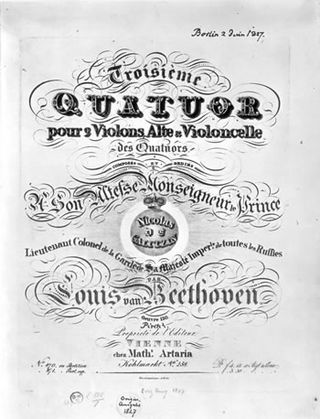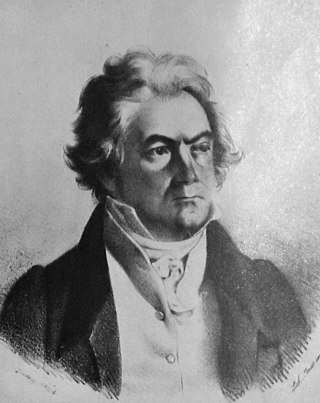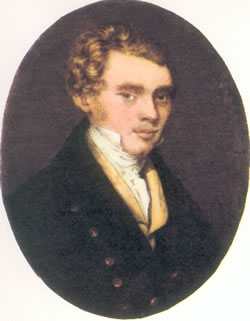Related Research Articles

Ludwig van Beethoven was a German composer and pianist. He is one of the most revered figures in the history of Western music; his works rank among the most performed of the classical music repertoire and span the transition from the Classical period to the Romantic era in classical music. Beethoven's career has conventionally been divided into early, middle, and late periods. His early period, during which he forged his craft, is typically considered to have lasted until 1802. From 1802 to around 1812, his middle period showed an individual development from the styles of Joseph Haydn and Wolfgang Amadeus Mozart, and is sometimes characterized as heroic. During this time, he began to grow increasingly deaf. In his late period, from 1812 to 1827, he extended his innovations in musical form and expression.

The term string quartet can refer to either a type of musical composition or a group of four people who play them. Many composers from the mid-18th century onwards wrote string quartets. The associated musical ensemble consists of two violinists, a violist, and a cellist.
In music, the opus number is the "work number" that is assigned to a musical composition, or to a set of compositions, to indicate the chronological order of the composer's publication of that work. Opus numbers are used to distinguish among compositions with similar titles; the word is abbreviated as "Op." for a single work, or "Opp." when referring to more than one work. Opus numbers do not necessarily indicate chronological order of composition. For example, posthumous publications of a composer's juvenilia are often numbered after other works, even though they may be some of the composer's first completed works.

The String Quartet No. 1 in F major, Op. 18, No. 1, was written by Ludwig van Beethoven between 1798 and 1800, published in 1801, dedicated to the Bohemian aristocrat Joseph Franz von Lobkowitz. It is actually the second string quartet that Beethoven composed.

Ludwig van Beethoven composed his String Quartet No. 4 in C minor, Op. 18, No. 4, between 1798 and 1800 in Vienna and published in 1801. The Op. 18 collection is dedicated to Joseph Franz von Lobkowitz.

The String Quartet No. 14 in C♯ minor, Op. 131, was completed by Ludwig van Beethoven in 1826. It is the last-composed of a trio of string quartets, written in the order Opp. 132, 130, 131.

The String Quartet No. 13 in B♭ major, Op. 130, by Ludwig van Beethoven was completed in November 1826. The number traditionally assigned to it is based on the order of its publication; it is actually Beethoven's 14th quartet in order of composition. It was premiered in March 1826 by the Schuppanzigh Quartet and dedicated to Nikolai Galitzin on its publication in 1827.
The three Razumovskystring quartets, opus 59, are a set of string quartets by Ludwig van Beethoven. He wrote them in 1806, as a result of a commission by the ambassador of the russian empire in Vienna, Count Andreas Razumovsky:

Ludwig van Beethoven's late string quartets are:

Ludwig van Beethoven is one of the most influential figures in the history of classical music. Since his lifetime, when he was "universally accepted as the greatest living composer", Beethoven's music has remained among the most performed, discussed and reviewed in the Western world. Scholarly journals are devoted to analysis of his life and work. He has been the subject of numerous biographies and monographs, and his music was the driving force behind the development of Schenkerian analysis. He is widely considered among the most important composers, and along with Bach and Mozart, his music is the most frequently recorded.
E major is a major scale based on E, consisting of the pitches E, F♯, G♯, A, B, C♯, and D♯. Its key signature has four sharps. Its relative minor is C-sharp minor and its parallel minor is E minor. Its enharmonic equivalent, F-flat major, has six flats and the double-flat B, which makes it impractical to use.

Ludwig van Beethoven completed his String Quartet No. 12 in E♭ major, Op. 127, in 1825. It is the first of his late quartets. Commissioned by Nicolas Galitzin over a year earlier, the work was not ready when it was scheduled to premiere. When it finally premiered by the Schuppanzigh Quartet, it was not well received. Only with subsequent performances by the Bohm Quartet and the Mayseder Quartet did it begin to gain public appreciation.

The String Quartet No. 15 in A minor, Op. 132, by Ludwig van Beethoven, was written in 1825, given its public premiere on November 6 of that year by the Schuppanzigh Quartet and was dedicated to Count Nikolai Galitzin, as were Opp. 127 and 130. The number traditionally assigned to it is based on the order of its publication; it is actually the thirteenth quartet in order of composition.

The String Quartet No. 8 in E minor, Op. 59, No. 2, was written by Ludwig van Beethoven and published in 1808. This work is the second of three of his "Rasumovsky" cycle of string quartets, and is a product of his "middle" period.

The Grosse Fuge, Op. 133, is a single-movement composition for string quartet by Ludwig van Beethoven. An immense double fugue, it was universally condemned by contemporary music critics. A reviewer writing for the Allgemeine musikalische Zeitung in 1826 described the fugue as "incomprehensible, like Chinese" and "a confusion of Babel". However, critical opinion of the work has risen steadily since the early 20th century and it is now considered among Beethoven's greatest achievements. Igor Stravinsky described it as "an absolutely contemporary piece of music that will be contemporary forever".
The Sonatas for cello and piano No. 4 in C major, Op. 102, No. 1, and No. 5 in D major, Op. 102, No. 2, by Ludwig van Beethoven were composed simultaneously in 1815 and published, by Simrock, in 1817 with a dedication to the Countess Marie von Erdődy, a close friend and confidante of Beethoven.

Karl Holz was an Austrian violinist. He played second violin in Ignaz Schuppanzigh's string quartet and served as secretary to Ludwig van Beethoven during the last few years of the composer's life. He was also close with Franz Schubert.

The Piano Quartets, WoO 36, by Ludwig van Beethoven are a set of three piano quartets, completed in 1785 when the composer was aged 14. They are scored for piano, violin, viola and cello. He composed a quartet in C major, another in E-flat major, and a third in D major. They were first published posthumously in 1828, however numbered in a different order: Piano Quartet No. 1 in E-flat major, Piano Quartet No. 2 in D major, and Piano Quartet No. 3 in C major.

Ludwig van Beethoven (1770–1827) was a German composer in the transition between the classical and romantic period. He composed in many different forms including nine symphonies, five piano concertos and a violin concerto. Beethoven's method of composition has long been debated among scholars. His sketches of composition drafts, and his written letters, provide contrasting evidence about his process of composition. However, many scholars agree that, for him, composition was a slow and laborious process. It is clear that his deafness impacted his compositional style, as evinced in certain changes in compositional method from early to late in his career.
References
- 1 2 Kerman, Joseph (1967). The Beethoven Quartets. New York: Knopf.
- ↑ "Beethoven's String Quartets". All about Beethoven. Retrieved 31 March 2010.
- ↑ Beethoven's Letters , p. 28, at Google Books. (1926 edition, Dent/Shedlock/Kalischer editing/translating.) "again" means, as Kerman corroborates in his discussion of the quartets, that this is a reference to the 2nd book - nos. 4-6 - not necessarily all six quartets, despite the editors' footnote in this edition of his letters.
- ↑ However, the early version of no. 1 - an autograph copy sent to, and kept by, Karl Amenda before Beethoven gave the quartet a thorough overhaul - is little-known and has been recorded, as of July 2014, less than six times.
- ↑ Kinderman, William (2010). The String Quartets of Beethoven. University of Illinois Press. p. 13. ISBN 0252091620.
- ↑ Kerman, Joseph (1979). The Beethoven Quartets. W. W. Norton & Company. p. 30. ISBN 0393009092.